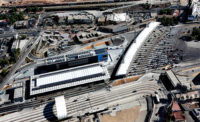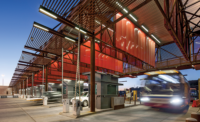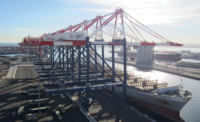San Ysidro Land Port of Entry, Phase 2
San Ysidro, Calif.
Best Project
Owner: U.S. General Services Administration Pacific Rim, Region 9
Lead Design Firm/Civil/Landscape/Acoustics/Lighting/HazMat/FFE: Stantec
General Contractor: Hensel Phelps
Structural Engineer: Coffman Engineers
MEP Engineer: MA Engineers (Mechanical & Plumbing) / Stantec (Electrical)
Architect of Record (Historic Customs House): Steinberg Hart Architects
Historic Architecture: IS Architecture
Subcontractors: Studio 08 Consultants; Jensen Hughes; Bergelectric; HPS Mechanical Inc.; ACCO Engineered Systems; Kimble & Co.; Best Interiors; Center Glass Co.; California Sheet Metal; Bonita Steel Erectors; Heery Intl.
Working at the busiest international border crossing in the Western Hemisphere, the Hensel Phelps team deconstructed and replaced existing pedestrian and bus inspection facilities while maintaining vital traffic flow between California and Mexico. The $157-million second phase of the multiphase San Ysidro Land Port of Entry project included construction of a 102,000-sq-ft northbound east pedestrian-processing facility; renovation and addition of the historic customs house; a pedestrian plaza; and new overhead pedestrian bridges.
The team used virtual reality design, enabling tenants to comment on details before construction and to plan for complex construction issues. With operational changes at existing facilities, the team updated and expanded the building program—extending the schedule and budget by owner-requested scope changes.
To accommodate border traffic without disruption, crews built an 18,000-sq-ft temporary facility and a multimodal transit center during the project’s early months.
When crews encountered unforeseen conditions at the historic customs house, the team scheduled work on that portion to start 10 months early, which kept the schedule on track.
Meanwhile, crews worked adjacent to the northbound roadway entry—which averages 50,000 vehicle crossings per day—and built a hardened, safety perimeter near traffic lanes. An additional 30,000 northbound pedestrians cross the border daily on a walkway that runs through the middle of the project site. The team covered the walkway for added protection from construction activities on one side of the walkway and the pedestrian building on the other side.
The two new pedestrian bridges were first built adjacent and parallel to the roadway. Once the bridges were ready to be erected, Customs and Border Protection diverted traffic for one evening, allowing crews to mobilize a crane and hoist the bridges within a 12-hour window.
The project was completed with no OSHA recordable incidents or lost-time accidents during 573,274 work hours.






Post a comment to this article
Report Abusive Comment